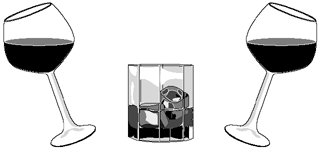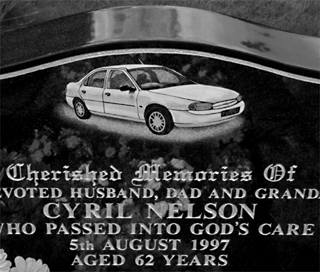| | 
26 August 2000- The Three Stages of Flight
- After reviewing my notes from yesterday’s ten-hour flight, I created The Three Stages of Flight before I had time to give the ideas much careful consideration. The print is best viewed in the PDF (Pretty Damn Fine) format.
I wish I had more easy times like this, even though I’m not sure what to do with the rest of the day. 
- 27 August 2000
- Ace’s Advice
- I went to the last of the summer’s three weddings, and it was a memorable celebration from what little I can remember.
Dr. Hayes, in his inimitable way with words, pronounced that the day represented “the end of fifty years of freedom and the beginning of fifty years of bliss.” As with the other two weddings, a salmon was sacrificed for the occasion. I’m not sure how this pagan tradition started, but I’m all for it. Like most other endangered species, salmon are yummy. And as is always the case, the guests were as generous with their advice as their hosts were with the champagne. Ace, the father of the groom, counseled, “Always give your wife what she wants. For example, my wife likes to work and likes to complain, so I give her lots of work and lots to complain about.” Seeing as how Ace and Midnight Lace (their citizens’ band radio nicknames that served them well during their days as truckers) have been married for fifty-four years, we all had to agree that those must be wise words. I think many other people may have made a number other insightful remarks that evening, but I forgot to write them down. That’s all right; writing is about the least efficacious things one can do at a wedding. 

- 28 August 2000
- Dead Man’s Car
- After reviewing the photographs I made in Britain, I was reminded that Americans don’t have a monopoly on motor vehicle fanaticism. Cyril Nelson, who now permanently resides two meters under Newcastle upon Tyne’s sooty soil, has a picture of his car on his headstone. It beats me why Nelson would want to have anything to do with a motor vehicle; he’s not going anywhere.

- 29 August 2000
- Ask Any Teledildonicist
- Predicting the future is difficult, and predicting the course of technology is even trickier. For example, Thomas Watson, the chairman of IBM, opined in 1943 that, “I think there is a world market for maybe five computers.” In 1949, the ever-optimistic editors at Popular Mechanics, predicted a rosy technological future. “While a calculator on the ENIAC is equipped with 10,000 vacuum tubes and weighs 30 tons, computers of the future may have only 1,000 vacuum tubes and weigh only 1.5 tons.” Even in 1977, Ken Olson, the founder of Digital Equipment Corporation, pronounced, “There is no reason why anyone would want a computer in the home.”
But enough anecdotes. A survey of new developments over the century shows that the military and pornographers are the first two groups to embrace new technologies. I’m pretty sure that’s what J.G. Ballard was thinking when he arrived at the formula, “Sex times technology equals the future.” Ask any teledildonicist; he’s absolutely right. 
- 30 August 2000
- Iceland Phallological Museum
- Sophie just returned from Reykjavik. I’ve heard there’s not much to do on that desolate island, and it turns out I heard correctly.
Sophie reported that she visited the Iceland Phallological Museum, of all places. She showed me a promotional blurb, boasting about, “a unique collection, the only one of its kind in the world, of over sixty penises and penal [sic] parts belonging to almost all the land and sea mammals that can be found in Iceland.” “So,” I asked, “what did you think of the collection?” “Not much,” Sophie replied, “when you’ve seen one you’ve seen one.” 
- 31 August 2000
- Craptacular!
- I visited a graphic arts trade show today, and saw lots of lovely toys. I was particularly impressed with the pretty new Apple computers. The company built a small auditorium in the middle of the vast convention center, complete with hundreds of spotlights. It might have been designed by Leni Riefenstahl, were it not for the fifteen-meter tall portrait of Martin Luther King.
As usual, the charlatans provided the best entertainment. One huckster was demonstrating his company’s “electronic book,” which was nothing more than an ordinary portable computer held on its side. “Once you’ve read like this,” he said with a nod toward the heavy computer and its dangling umbilical cords, “you’ll never want to go back to regular books.” Another quack was waving an electronic tablet over his head, proclaiming the gadget to be “the tool that turned me into an artist.” And then there was the “digital atelier,” featuring “original fine art and unique editions using the latest computer equipment.” Call me a Philistine, but I failed to discern any nuances between insipid watercolors created with ten thousand dollars worth of computer equipment and bland watercolors made with two dollars worth of paint. That’s progress! One of the featured artists coined and trademarked a new word to describe her oeuvre: “tradigital.” I’ll do the same to give the “electronic art” a one-word review ... Craptacular! 
- 1 September 2000
- Taking Care of Work
- I had a couple of drinks with Jim Marshall tonight. He was in a relatively good mood, having sold nine of his prints for a thousand dollars each earlier in the day. He cheerfully reported that he’s also selling tens of thousands of books of his photographs.
When I first met Jim fifteen years ago, he was far from affluent. I remember buying a number of prints from him for six hundred dollars; that allowed him to pay his rent. Since his portraits of famous musicians were mostly made in the 1960s and early 1970s, I asked him why he was selling so many more prints now than in the 1980s. “I take care of my work and my work takes care of me,” Jim explained. Of course, that wasn’t an explanation at all, but it sounded good after a Marshall-sized martini. 
- 2 September 2000
- The Aesthetics of Appearance
- I have dozens of reasons for not being a dancer, most of which I’ve already mentioned. I especially dislike one of the premises of dance aesthetics: dancers must make their difficult feats look easy, effortless. That’s wrong.
Jeff Beck has the right idea when it comes to appearances and difficulty: “I like to play easy things that sound hard.” I agree that it’s a good idea to fool the audience into grossly overestimating the competence and hard work of the artist. Anything else is just silly. 
- 3 September 2000
- Not Fünny
- I can’t figure out why everyone’s talking about umlauts this year, but they are.
David Myers, a psychologist from Hope College in Michigan, says that Germans need to frown when pronouncing characters with umlauts, such as “ü.” “Research has shown that the facial expression of a person can affect how funny they find cartoons,” says Myers. “Saying the ‘e’ and ‘ah’ activates the smiling muscles in the face and puts people in a better mood than saying the German ‘ü,’ which activates the muscles associated with negative emotions.” Myers has just concluded his sabbatical stay at St. Andrews University in Scotland, where he used electrodes to manipulate facial muscles. His research led him to conclude that people who frowned had ... ... here comes the punch line ... ... a lowered sense of humor! A reporter with the improbable name of Auslan Cramb reported that the German consulate in Edinburgh refused to comment on the report, saying the theory was “too scientific.” Who says Germans don’t have a sense of humor? Not me! 
last transition | index | next transition
©2000 David Glenn Rinehart
| |

